A Brief Guide to Choosing your Knife
Have you ever wondered how to choose a chef’s knife? What would you have to take in consideration at the moment of your purchase? What type of handle materials are out there? And what is the best steel for your necessities?
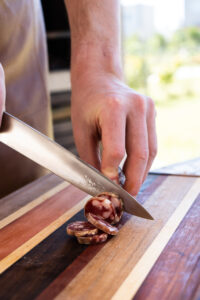
With this brief little guide you’ll be ready to take home the knife you know suits you best.
We’ll talk about the matrial of the handles, the shapes of the blade, and the A B C for knowing the basic features of the steel. After reading this brief guide, you’ll be able to choose a knife by yourself.
Handles
The handle is one of the main aspects to take into account when choosing your knife. In Pampa’s, we propose a wide range of materials for the handles, all of natural origin and artisanal production. We work with the best artisans of our country, who take the raw material from the regions they live in and labour it untill they have a nice and ready-to-use handmade knife.

Our recommendation when it comes to handle, is to look at your hand. Your knife should feel like it belongs to your body, like an extention of your arm. Getting a handle too big or too small could break this harmony, making it uncomfortable at the use. The handle should feel comfortable and secure, ideally ergonomic.
Wood & Braided
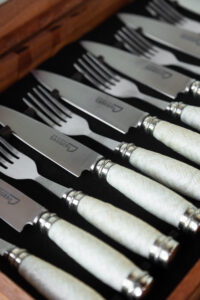
A wooden grip is always convenient. It’s a classic, reliable and a guarantee of trust. All our wooden knives are made with wood from different regions of Argentina, where the trees grow according to their natural necessities. And, although you might think that wood is a porous surface, ours is treated to give it a shiny, sealed finish. On the other hand, our braided models have a wooden base but a delicate and dedicated work over them. It consists of a cowhide braided pattern, which is tinted in different colors according to the needs and wants of the craftman.
Alpaca or Nickel Silver
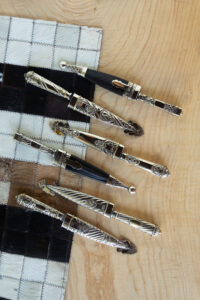
Nickel Silver, German Silver or Alpaca, is chosen mainly for its resistance to corrosion and the passage of time. craftsmen prefer it for its ease of being molded at the moment of work in a room temperature. In addition, it’s aesthetically similar to silver in it’s appearance. When we get involved with this material, we really let our imagination flow. Our Nickel Silver handles carry on them a handmade chiselled work with different designs to pick from. This characteristics makes it a distinguished material for a handle, therefore giving us an elegant knife. Its ideal for a gift, and perfect for those who care for resistance in a knife, but also beauty.
Cow Horn, Deer Antler & Bone
Finally, we arrive to other materials. This type of finish is rare on a kitchen knife, automatically making it unique and high-end. Don’t be fooled by their eccentricity, they are just as ergonomic and comfortable as any other material (or even more so).
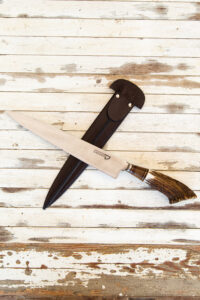
The Deer Antler Controversy
Our actuality is filled with new visions and new ways of treating our pairs and our environment. One of the things we’ve learned these last few years, is to live in harmony with nature, leaving behind the times of careless exploitation. So, aligned with that premise and value, where do the deer antlers we use come from?

Simple, they fall naturally during the last weeks of winter and the first of spring, this being part of the reproductive cycle of the deers. This happens every year during the last weeks of winter or the first ones of spring. Once the antlers fill the ground and deers are no more in sight, they are picked up with the least intervention of the ecosystem. This way, we guarantee ourselves and our costumers that our products are as faithful to our believers as us, making knives that come from nature and respecting it.
Blade
When it gets to the shape of your knife, you should also keep in mind the purpose of it. As you’d know, there are knives for anything: bread, fillet, cheese, and we could go on and on. On the other hand, there’s a huge variety of blade sizes when it comes to know how to choose your knife.
Among all these combinations and options, what should you have in mind? The blade must adapt to your purpose and chores for what you’ll need it for, because that’s why there are so many different models. Craftsmen keep the intention of the knife in mind when creating it, so there is going to be one out there specially designed for what we want to do. Different knives, have different purposes.
Parts of a knife blade
And since we are here, we leave you with a quick review of the parts of the knife blade.

Defense or heel
A knife with an integrated metal defense and blade and tang in one piece is a knife for many years of use. It is the part adjacent to the handle, which helps to balance the weight of the knife and protect the hand.
Spine
Another part to consider is the “spine”. This is the edge directly opposite the cutting side of the cutting edge. Is occasionally used to squash or crunch things you don’t want to cut.
The Tip and the Point
The tip is the front quarter of the blade. It’s with the part that the most delicate and fine work over the food is done. While the point is usually for simpler cutting work.
Bonus: Alveoli
In some types of knives, such as Santoku Knives (in which we talk about in our How many types of Knives are there? post), oval “notches” called alveoli appear along the blade. These are very useful, since they prevent food from sticking.
Steel
The quality of the steels used in the production of kitchen knives and their manufacturing process influence quality and price. Steel is simply the alloy of Iron with a small proportion of carbon that provides great hardness and elasticity. The alloys contain different, components which provide different qualities depending on the proportions and combinations of those components.
The three most important qualities of a blade are its ability to cut, the ease of sharpening it once the knife requires it, and its resistance to rust.
These aspects are the product of the good quality of the raw steel and the correct heat treatment applied in it’s forge. And subsequently, the proper performance of the manufacturing processes is the last touch to make a great knife.
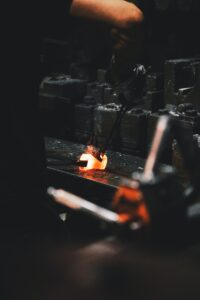
Carbon Steels, for example, are made up of iron and carbon between 0.2 to 2%, and Stainless Steels add chromium percentages between 12 and 17% to carbon steel. Carbon ensures hardness. While Chrome provides the quality of stainless.
The hardness of the blade of the knife is valued by means of a measurement index. Its called the “Rockwell HRC” (Hardness Rockwell Scale). For knives for daily use, hardnesses between 52 and 56 HRC are expected, for premium knives, hardnesses between 56 and 65 HRC are expected. Our Damascus Steel Knives, for example, have 60 +/- 1 HRC.
This is a factor to have in mind. On one hand, a high Carbon Steel will keep its edge sharp for longer periods of time and are more resistant to the daily use. On the other, a high Stainless Steel has greater resistance to oxidation. It also has better flexibility and versatility, avoiding cracking, so it can be stored comfortably and practically.
Going to the vast store of Pampa’s Way

So, what do you have to consider when you buy a knife?
That the handle feels part of your body. The size and shape of the blade fitts your purpose. And the steel is up to your expectations.
From Cow Horn to Wood and Bone, including Nickel Silver and Carved models, and even more options of handles that adapt to you. Below blades made of the best Stainless Steel and a purely artisan Damascus with Stainless Steel SS316 + VG10 japanese Steel. Here at Pampa’s Way we offer you handcrafted knives for cooking, both in the kitchen and outdoors. That is why they are chosen for day-to-day use and for camping. They’re one of those knives you’d like to have in your pack, and that’ll became indispensable.
Take a look at our store, and find the knife that you were thinking about the hole time you were reading this post.